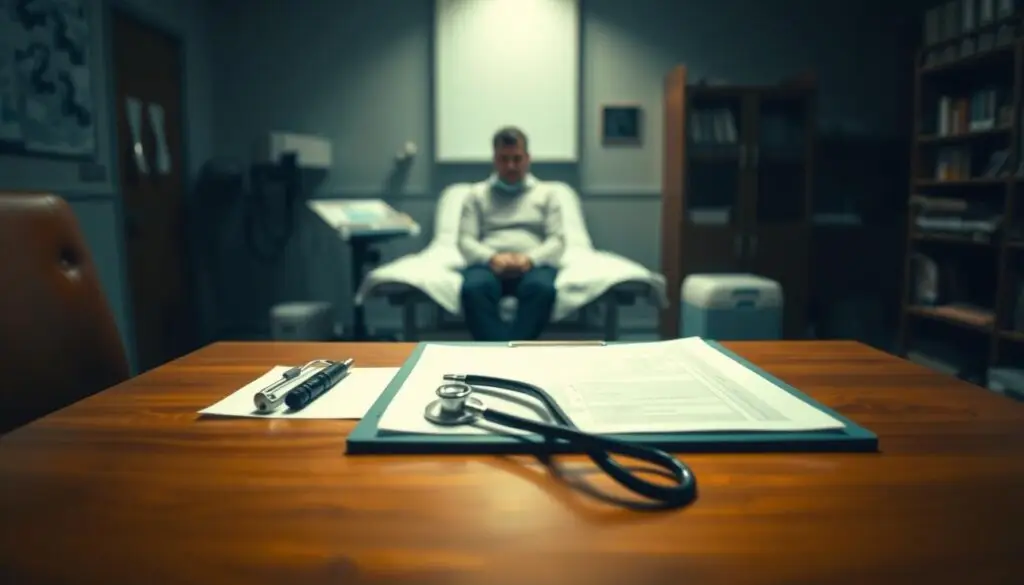You may be more than just tired. If your daily energy collapses after normal activity or rest does not help, this article gives clear, practical information to help you recognize when a pattern points to a real illness.
Myalgic encephalomyelitis/chronic fatigue syndrome (often called cfs) affects many body systems. Core issues include severe fatigue lasting six months or more, sleep problems, and post-exertional malaise.
You will learn key differences between everyday chronic fatigue and a fatigue syndrome that limits work, school, and family life. This section outlines common symptoms, what testing usually includes, and practical steps to stabilize energy without pushing into a crash.
Read on for evidence-informed ways to track changes, talk with your provider, and protect your long-term health.
Key Takeaways
- Learn how lasting low energy differs from true Signs of Chronic Fatigue Syndrome and when to seek care.
- Recognize core symptoms like post-exertional malaise, sleep disruption, and widespread pain.
- Understand common evaluation steps and why tests rule out other causes.
- Find practical management options: pacing, sleep habits, selective treatments, and counseling.
- Get clear, usable information to discuss with your clinician and protect your daily life.
What ME/CFS Is—and Why Your Fatigue Isn’t “Just Being Tired”
What looks like ordinary tiredness can actually reflect widespread changes in how your body handles effort. Myalgic encephalomyelitis is a multi-system condition that affects energy, the nervous system, and immune responses.
How myalgic encephalomyelitis affects multiple body systems
Your nervous and immune systems can stay activated or misfire, causing fluctuating symptoms that touch many parts of the body. You may feel flu-like, wake up stiff, or have broken sleep. Cognitive slowdowns—what many call “brain fog”—make thinking slow, memory weak, and words harder to find.
With this syndrome, normal rest and sleep often do not refresh you. Energy metabolism and autonomic regulation can be disrupted, so even light tasks may trigger delayed worsening known as post-exertional malaise. That mismatch—the system overreacting to small efforts—is a key reason clinicians use the word syndrome rather than a single cause.
- Core features last six months or more and limit activity.
- Tracking patterns helps you avoid the common push-and-crash cycle.
- Clear descriptions help your provider see the full scope of your experience.
Core Signs of Chronic Fatigue Syndrome You Shouldn’t Ignore
If routine tasks now exhaust you for six months or longer, you need to track what happens next. This pattern—lasting reduced activity plus severe tiredness that doesn’t improve with rest—is a central diagnostic clue for chronic fatigue syndrome.
Persistent, activity-limiting fatigue
When your ability to work, study, or care for yourself falls sharply for months, document how daily tasks change. That timeline—measured in months, not days—helps differentiate a brief setback from a true fatigue syndrome.
Post-exertional malaise (PEM)
PEM means symptoms worsen after physical or mental effort, often hours or days later. Even modest activity can trigger a delayed crash that takes far longer than usual to recover from.
Unrefreshing sleep and cognitive problems
Waking unrefreshed, frequent awakenings, or shifted sleep times commonly add to daytime fatigue. You may also notice slowed thinking, trouble concentrating, or short-term memory problems—what many people call “brain fog.”
Orthostatic intolerance and related issues
Feeling dizzy, lightheaded, or weak when upright that eases when you lie down is common. Also note any new or increased pain, sore throat, or tender lymph nodes.
- Keep a daily log to link activities with next-day symptom intensity.
- Note timing and recovery length for crashes.
- Share a concise symptom record with your clinician and review resources like early burnout guidance to compare patterns.
Other Symptoms That Often Travel with ME/CFS
You may also experience a mix of pain, sensory sensitivities, and digestive changes that come and go. These extra issues can shape how you plan your day and talk with your provider.
Pain that moves around
Muscle and joint aches, headaches, sore throat, and tender lymph nodes are common. Log where the pain appears, what seems to trigger it, and how intense it feels.
If muscle or nerve pain rises after activity, slow your pace and add rest breaks to limit worsening and protect against post-exertional crashes.
Heightened sensitivities
Light, sound, certain foods, strong odors, or chemicals can feel overwhelming. Simple environmental tweaks—dimming lights, reducing background noise, avoiding triggers—often lower day-to-day symptom load.
Medication sensitivity is also reported; start low and go slow with new treatments and discuss changes with your clinician.
Digestive and temperature issues
Digestive problems such as IBS, nausea, or appetite loss can flare with chills, night sweats, or trouble keeping a steady temperature. These shifts reflect how the immune and nervous system respond to everyday inputs.
- Track other symptoms in a short daily note to capture patterns.
- Be flexible in plans so you can rest on tougher days without guilt.
- Bring a written summary of other symptoms to appointments so nothing gets missed in the overall assessment.
Who Gets ME/CFS in the United States?
Many people can develop this condition, but you should know it affects some groups more often. Adult women and people aged 40–60 are the most frequently diagnosed in the U.S.
Children and teens can also have the illness. In many children, symptoms fluctuate and some recover fully, yet persistent limitations in activities or school need attention and support.
Patterns across ages and families
Severity varies widely. Some people have mild limits, while others are home- or bed-bound. Share any family history of similar post-infectious problems with your provider.
Daily life and accommodations matter. Work and school adjustments can prevent symptom escalation. Tailoring plans to your age and roles helps protect energy over time.
- Track the symptoms that interrupt your life most.
- Ask for school or workplace accommodations early.
- Follow current research summaries to learn who is most at risk and why.
| Group | Common pattern | Typical impact on activities |
|---|---|---|
| Adult women | Higher prevalence; onset often in midlife | May reduce work hours or require accommodations |
| Adults 40–60 | Most commonly diagnosed age range | May affect career and family roles |
| Children & teens | Can recover fully; symptoms may fluctuate | School adjustments often needed |
| Family clusters | Some families report shared patterns | Discuss family history with your clinician |
Possible Causes and Triggers Under Investigation
No single cause explains why myalgic encephalomyelitis starts. Current research explores several likely pathways so you can understand how onset often follows an event.
Infections, immune system changes, and energy metabolism
Many people report symptoms began after infections. Scientists study how viruses and bacteria might alter immune responses and cellular energy supply.
Evidence suggests disrupted cellular energy production can leave you unable to recover after routine activity. That change may work with immune shifts to produce lasting symptoms.
Stress, trauma, surgery, and genetics in some families
Significant life stress, physical trauma, or surgery can precede onset for some people. These events add to your body’s load and may tip fragile systems into illness.
Family patterns suggest a possible genetic susceptibility. If relatives had similar post‑infectious starts, mention that to your clinician.
Why researchers think multiple triggers may interact
Researchers now favor a model where two or more triggers combine. An infection plus major stress, for example, may produce a different outcome than either alone.
Practical steps: keep a clear timeline of illnesses, vaccines, surgeries, travel, and stressors. That record helps your provider piece together likely causes and guide testing.
- Post-infectious onset is common—note timing after illnesses.
- Think in terms of overall system load: physical and mental stressors stack.
- Expect ongoing research updates as scientists test interacting triggers and mechanisms.
| Potential trigger | What researchers study | How you can track it |
|---|---|---|
| Infections | Immune activation, persistent viral effects | Record recent illnesses and recovery timelines |
| Immune shifts | Autoimmune markers, inflammation patterns | Note recurrent sore throat, swollen nodes, fever |
| Energy metabolism | Cellular ATP, mitochondrial function | Track activity limits and delayed crashes |
| Stress/trauma/surgery | Physiologic load and recovery capacity | Log major life events and symptom changes |
How ME/CFS Is Diagnosed When There’s No Single Test
Getting an accurate diagnosis matters because there isn’t a single lab test that proves this condition. Your provider pieces together a picture from your history, exams, and targeted testing to reach a working diagnosis.

Your clinical history, physical and mental status exams
Your clinician will ask detailed questions about when symptoms started, how they change on “good” and “bad” days, and how they limit your life over months. Expect a focused review of sleep, thinking, standing tolerance, and activity-triggered crashes.
Physical and mental status exams document objective findings and help rule out other health problems. Bring a medication and supplement list and note any sensitivities.
Blood, urine, and other tests to rule out look‑alike conditions
Standard work-ups include simple blood and urine tests to exclude thyroid disease, anemia, infections, and autoimmune disorders. These tests are not diagnostic for cfs but are essential to rule out other conditions.
When your provider may involve specialists
Specialists in neurology, cardiology, or sleep medicine may evaluate orthostatic intolerance, sleep disorders, or neuropathic pain. Referrals target the problems that most impact you.
“Diagnosis is a process: careful history and exclusion, not a single lab result.”
| Step | What it checks | Why it matters |
|---|---|---|
| Detailed history | Symptoms over time, triggers, life impact | Confirms pattern of months-long, nonrestorative fatigue with PEM |
| Physical & mental exams | Objective signs, cognitive function, orthostatic response | Rules out other neurologic or psychiatric causes |
| Blood & urine tests | Thyroid, CBC, metabolic, infection screens | Excludes conditions that mimic cfs and guides treatment |
Evidence-Informed Management: What Helps You Day to Day
Small, practical steps often steady your energy and cut down crashes. Management is personal, so try approaches slowly and note what helps.
Pacing and activity management
Use pacing to match tasks to your current capacity. Plan short bursts of activity with built-in rest to prevent delayed worsening.
Sleep and when to seek a specialist
Prioritize consistent sleep habits: regular bedtimes, low light, and quiet evenings. If sleep problems persist, ask about a sleep specialist evaluation.
Medications, nutrition, and gentle therapies
Consider targeted medication for pain, orthostatic symptoms, or sleep, using “start low, go slow” because sensitivities are common.
Discuss supplements with your clinician and favor gentle therapies—breathwork, soft-tissue work, and guided relaxation—that lower stress reactivity.
Counseling and practical tools
Cognitive behavioral therapy and counseling help with coping and mood but are not cures. Use wearables or timers to limit activities before symptoms rise.
“Pacing and clear routines often prevent the push-and-crash cycle and protect your daily function.”
| Strategy | What it targets | Quick tip |
|---|---|---|
| Pacing | Post-exertional worsening | Plan activity with timed rests |
| Sleep hygiene | Unrefreshing sleep | Consistent schedule; seek specialist if needed |
| Medications | Pain, orthostatic symptoms, sleep | Start low; monitor sensitivities |
| Nutrition & gentle therapy | Appetite, stress, symptom load | Coordinate supplements with your provider |
Quick flare plan: cut demands, hydrate, rest, and tell one person what you need. Review treatments with your clinician before trying new options for cfs or myalgic conditions.
Living Better with ME/CFS: Practical Strategies You Can Start Now
Small planning steps help you keep control over your day when energy is limited. Start with a short energy diary to link activities to next-day symptoms. Record the time spent, the task, and how you felt later.

Use simple tools like a notebook, phone notes, or a calendar. Build an activity budget: cap work or chores into short blocks and add recovery windows before you feel worse.
Building an energy diary to spot patterns and plan rest
Note what triggers increased fatigue and how long recovery takes. Track mood and any depression so you can address emotional problems early.
Adapting school, work, and daily activities—asking for support early
Ask for reduced hours, flexible deadlines, or remote time before capacity drops. Create short scripts to explain needs to family, teachers, and employers.
- Use timers and wearable alerts to keep activity within limits.
- Pack a small flare kit for outings: earplugs, water, salty snack for orthostatic issues.
- Review your plan weekly and tweak time blocks to fit real life.
“Planning ahead saves time and prevents crashes.”
ME/CFS in Children and Teens: What You and Your Family Should Know
When a child’s play or schoolwork suddenly becomes too hard for months, you should take note and seek guidance.
Watch key symptoms such as prolonged, activity‑limiting tiredness, delayed crashes after sports or study, trouble sleeping, and brain fog that affects homework and learning.
Ask the school for flexible schedules, reduced workloads, a quiet rest space, and remote options so your child can keep up without worsening.
- Build family routines that use pacing—short activities with planned rests to avoid long setbacks.
- Teach your child to notice early warning cues like heavy legs, dizziness, or trouble focusing and to take breaks when needed.
- Coordinate closely with pediatric providers to rule out other causes and to tailor care as your child grows.
Celebrate small gains and avoid pushing capacity. Consistency usually helps more than intensity.
Prepare backup plans for social and extracurriculars so your child stays connected without triggering flares. Share regular updates with teachers and coaches to reduce misunderstandings and set fair expectations.
| Area | What to request | Why it helps |
|---|---|---|
| School schedule | Shortened days, flexible deadlines | Prevents late-day crashes and protects learning |
| Classroom support | Quiet rest area, extra time for tests | Reduces stress and preserves stamina |
| Medical coordination | Regular check-ins with pediatrician | Rules out other causes and adapts care with growth |
When to Talk to a Healthcare Provider—and Red Flags You Shouldn’t Wait On
If daily tasks leave you depleted and recovery takes days, contact your clinician for an evaluation. Early review helps sort common causes and guides appropriate tests and referrals.
Signs it’s time for evaluation or re‑evaluation
What to watch for
Seek care when fatigue and related symptoms are persistent, life‑limiting, or worsening over weeks to months. Note unrefreshing sleep, cognitive decline, or orthostatic intolerance that limits standing or activity.
Bring concise information: symptom timelines, activity limits, medication sensitivities, and your top goals for function. This short summary speeds a good diagnosis and helps decide which tests to run.
Urgent red flags
Go to urgent care or the ER for chest pain, severe shortness of breath, new focal neurologic changes (weakness, slurred speech), or fainting with injury. These signs require immediate assessment beyond routine follow-up.
Why be cautious about unproven treatments
Many costly, marketed “cures” lack solid research. Ask for evidence, potential harms, and alternatives before trying aggressive protocols. Discuss new treatment or therapy options with your provider to avoid worsening or medication sensitivity.
“Revisit your diagnosis if symptoms change significantly; some cases evolve and benefit from new tests or referrals.”
| When | What to mention | Why it matters | Next steps |
|---|---|---|---|
| Persistent, life‑limiting fatigue | Timeline and activity limits | Helps confirm a working diagnosis | Primary care visit; basic blood/urine tests |
| Orthostatic symptoms | Dizziness, fainting, heart rate changes | Suggests autonomic system review | Referral to cardiology or autonomic clinic |
| New severe or focal problems | Chest pain, severe breathlessness, limb weakness | May indicate serious other conditions | Urgent care or ER evaluation |
| Considering a new costly therapy | Research evidence and side effects | Avoid unproven risks and expense | Discuss with clinician; seek second opinion |
Practical tips: keep a one‑page symptom timeline, ask which tests are appropriate for infections, autoimmune markers, or blood abnormalities, and consider counseling if depression or stress affects your ability to follow a treatment plan.
Conclusion
If this information fits your experience, take one next step: book a focused visit with a clinician who understands prolonged energy problems and can start a structured evaluation.
Begin with doable, evidence-informed actions you can sustain: pacing, improved sleep habits, and symptom‑targeted strategies. Keep a brief energy diary to show real-world limits and to guide your plan.
Partner with your provider to adjust medications and therapies over time. Involve family, teachers, or employers early so practical support keeps your day steady and protects long-term function.
Be cautious about expensive or sensational claims; ask for evidence and value safety and function first. Track simple milestones—more steady mornings, fewer crashes, clearer focus—to measure meaningful progress.
Remember: you are not alone. With careful evaluation, pacing, and consistent self‑management many people find a more stable path forward.



